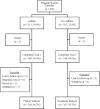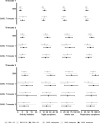Maternal body composition and gestational weight gain in relation to asthma control during pregnancy
- PMID: 35442986
- PMCID: PMC9020691
- DOI: 10.1371/journal.pone.0267122
Maternal body composition and gestational weight gain in relation to asthma control during pregnancy
Abstract
Background: Poor asthma control is common during pregnancy and contributes to adverse pregnancy outcomes. Identification of risk factors for poor gestational asthma control is crucial.
Objective: Examine associations of body composition and gestational weight gain with asthma control in a prospective pregnancy cohort (n = 299).
Methods: Exposures included pre-pregnancy body mass index (BMI), first trimester skinfolds, and trimester-specific gestational weight gain. Outcomes included percent predicted forced expiratory volumes (FEV1, FEV6), forced vital capacity (FVC), peak expiratory flow (PEF), FEV1/FVC, symptoms (activity limitation, nighttime symptoms, inhaler use, and respiratory symptoms), and exacerbations (asthma attacks, medical encounters). Linear and Poisson models examined associations with lung function (β (95% confidence interval (CI)), asthma symptom burden (relative rate ratio (RR (95%CI)), and exacerbations (RR (95%CI)).
Results: Women with a BMI ≥ 30 had lower percent predicted FVC across pregnancy (βThirdTrimester: -5.20 (-8.61, -1.78)) and more frequent night symptoms in the first trimester (RR: 1.66 (1.08, 2.56)). Higher first trimester skinfolds were associated with lower FEV1, FEV6, and FVC, and more frequent night symptoms and inhaler use across pregnancy. Excessive first trimester gestational weight gain was associated with more frequent activity limitation in the first trimester (RR: 3.36 (1.15, 9.80)) and inhaler use across pregnancy (RRThirdTrimester: 3.49 (1.21, 10.02)).
Conclusions: Higher adiposity and first trimester excessive gestational weight gain were associated with restrictive changes in lung function and symptomology during pregnancy.
Conflict of interest statement
The authors have declared that no competing interests exist.
Figures




Similar articles
-
The effect of early growth patterns and lung function on the development of childhood asthma: a population based study.Thorax. 2018 Dec;73(12):1137-1145. doi: 10.1136/thoraxjnl-2017-211216. Epub 2018 Jul 31. Thorax. 2018. PMID: 30064992
-
Late-pregnancy dysglycemia in obese pregnancies after negative testing for gestational diabetes and risk of future childhood overweight: An interim analysis from a longitudinal mother-child cohort study.PLoS Med. 2018 Oct 29;15(10):e1002681. doi: 10.1371/journal.pmed.1002681. eCollection 2018 Oct. PLoS Med. 2018. PMID: 30372451 Free PMC article.
-
Gestational weight gain during the second and third trimesters and adverse pregnancy outcomes, results from a prospective pregnancy cohort in urban Tanzania.Reprod Health. 2022 Jun 16;19(1):140. doi: 10.1186/s12978-022-01441-7. Reprod Health. 2022. PMID: 35710384 Free PMC article. Clinical Trial.
-
Developmental trajectories of Body Mass Index from infancy to 18 years of age: prenatal determinants and health consequences.J Epidemiol Community Health. 2014 Oct;68(10):934-41. doi: 10.1136/jech-2014-203808. Epub 2014 Jun 3. J Epidemiol Community Health. 2014. PMID: 24895184 Free PMC article.
-
Association between trimester-specific gestational weight gain and childhood obesity at 5 years of age: results from Shanghai obesity cohort.BMC Pediatr. 2019 May 2;19(1):139. doi: 10.1186/s12887-019-1517-4. BMC Pediatr. 2019. PMID: 31046723 Free PMC article.
Cited by
-
Maternal asthma in relation to infant size and body composition.J Allergy Clin Immunol Glob. 2023 Aug;2(3):100122. doi: 10.1016/j.jacig.2023.100122. Epub 2023 May 30. J Allergy Clin Immunol Glob. 2023. PMID: 37485032 Free PMC article.
-
Assessing adverse pregnancy outcomes in women with uncontrolled asthma vs. mild asthma: a retrospective comparative analysis.Arch Gynecol Obstet. 2024 Sep;310(3):1433-1440. doi: 10.1007/s00404-023-07347-4. Epub 2024 Jan 26. Arch Gynecol Obstet. 2024. PMID: 38276984
-
Short-term exposure to ozone and asthma exacerbation in adults: A longitudinal study in China.Front Public Health. 2023 Jan 6;10:1070231. doi: 10.3389/fpubh.2022.1070231. eCollection 2022. Front Public Health. 2023. PMID: 36684992 Free PMC article.
-
The impact of body position on vital capacity among pregnant women in the second trimester.Front Med (Lausanne). 2024 May 27;11:1351681. doi: 10.3389/fmed.2024.1351681. eCollection 2024. Front Med (Lausanne). 2024. PMID: 38863888 Free PMC article.
-
Treatable Traits in Pregnant Women with Asthma.Respiration. 2024;103(4):217-232. doi: 10.1159/000536455. Epub 2024 Mar 12. Respiration. 2024. PMID: 38471469 Free PMC article. Review.
References
-
- Centers for Disease Control and Prevention. 2018 National Health Interview Survey (NHIS) Data 2018 [updated December 17, 2019; cited 2019 December 21, 2019]. Available from: https://www.cdc.gov/asthma/nhis/2018/table4-1.htm.
-
- Kemppainen M, Lahesmaa-Korpinen AM, Kauppi P, Virtanen M, Virtanen SM, Karikoski R, et al.. Maternal asthma is associated with increased risk of perinatal mortality. PLoS One. 2018;13(5):e0197593. Epub 2018/05/19. doi: 10.1371/journal.pone.0197593 ; PubMed Central PMCID: PMC5959067. - DOI - PMC - PubMed

